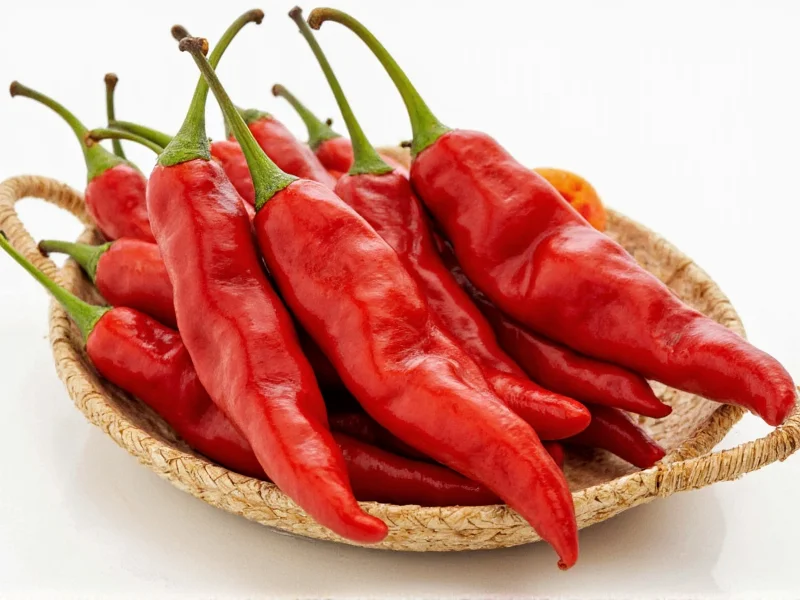Understanding the unique characteristics of guajillo and ancho chilies is essential for authentic Mexican cooking. These two dried peppers form the foundation of many traditional sauces, moles, and stews, but their flavor profiles and heat levels differ significantly. Choosing the right pepper can make or break your dish, whether you're preparing a vibrant salsa roja or a complex mole poblano.
What Are Guajillo and Ancho Chilies?
Guajillo and ancho chilies represent two of the most important dried peppers in Mexican culinary tradition. While both originate from fresh chili peppers that undergo a drying process, they come from completely different varieties with distinct flavor profiles and culinary applications.
Chile Guajillo: The Tangy Workhorse
Guajillo chilies come from the mirasol pepper ( Capsicum annuum) that's dried after reaching full maturity. These slender, reddish-brown peppers measure approximately 3-6 inches long with smooth, shiny skin. When rehydrated, guajillos release a complex flavor profile featuring:
- Bright, tangy notes reminiscent of green tea
- Subtle berry undertones (particularly raspberry)
- Floral hints with a clean finish
With a Scoville heat rating of 2,500-5,000 units, guajillos provide medium heat that builds gradually. They're essential in classic preparations like salsa roja, adobo sauce, and the marinade for carne asada. Professional chefs often toast guajillo peppers before rehydrating to enhance their natural fruitiness.
Chile Ancho: The Sweet Mole Foundation
Ancho chilies are actually dried poblano peppers, making them significantly larger than guajillos—typically 4-6 inches wide with an irregular, heart-shaped form. Their deep mahogany color and wrinkled texture distinguish them visually. Anchos deliver a completely different flavor experience:
- Pronounced sweetness with notes of dried fruit
- Earthy undertones reminiscent of coffee
- Subtle hints of tobacco and raisin
As one of the mildest dried chilies (1,000-2,000 SHU), anchos provide warmth without overwhelming heat. They serve as the base for Mexico's national dish, mole poblano, and feature prominently in chiles en nogada and many traditional tamales. Unlike guajillos, anchos develop richer, more complex flavors when soaked rather than toasted.
Comparing Guajillo and Ancho Peppers
| Characteristic | Guajillo Pepper | Ancho Pepper |
|---|---|---|
| Origin Fresh Pepper | Mirasol | Poblano |
| Shape & Size | Slender, 3-6" long, smooth skin | Wide, heart-shaped, 4-6" across, wrinkled |
| Color | Bright reddish-brown | Deep mahogany |
| Heat Level (SHU) | 2,500-5,000 (medium) | 1,000-2,000 (mild) |
| Flavor Profile | Tangy, berry notes, green tea | Sweet, raisin, coffee, earthy |
| Best Preparation Method | Dry toast before soaking | Soak without toasting |
| Signature Dishes | Salsa roja, adobo, carne asada marinade | Mole poblano, chiles en nogada, tamales |
When to Substitute One for the Other
While guajillo and ancho peppers aren't perfect substitutes due to their different flavor profiles, understanding appropriate swaps can save your recipe when one pepper isn't available. For guajillo pepper substitute options, consider:
- California peppers (milder, less tangy)
- Chiles de árbol (hotter, similar fruitiness)
- Mixture of paprika and a touch of cayenne
For ancho pepper alternatives, try:
- Mulato peppers (similar flavor, slightly hotter)
- Guajillo peppers with a pinch of sugar (for sweetness)
- Dried pasilla with a touch of cocoa powder
When substituting guajillo for ancho in recipes, remember to add a small amount of sugar to compensate for the missing sweetness. Conversely, when replacing ancho with guajillo, consider adding a splash of vinegar to mimic the tangy notes.
Maximizing Flavor in Your Cooking
Proper preparation makes all the difference when working with dried chilies. For guajillo peppers, remove stems and seeds, then dry toast in a skillet over medium heat for 20-30 seconds per side until fragrant but not burnt. Soak in hot water for 15-20 minutes until pliable. Anchos require more careful handling—remove seeds gently (they're more fragile), and soak directly in 180°F water for 20 minutes without toasting to preserve their delicate sweetness.
The liquid from rehydrating both peppers contains valuable flavor compounds. Strain and reserve this chile soaking liquid to use in place of water or broth in your recipes. This technique significantly enhances the depth of flavor in moles, stews, and sauces while maintaining authentic taste profiles.
Where to Find Quality Dried Chilies
When selecting dried chilies, look for pliable peppers with intact skin and a rich, deep color. Avoid brittle, broken, or moldy specimens. Specialty Mexican markets typically offer the freshest selection, but well-stocked grocery stores increasingly carry dried chilies in their international sections. For online sources, seek retailers who specify harvest dates and storage conditions, as dried chilies lose flavor compounds over time.
Storing Dried Chilies Properly
To maintain optimal flavor, store dried chilies in airtight containers away from light and heat. A dark pantry works well for short-term storage (up to 6 months), but for longer preservation, freeze your chilies in vacuum-sealed bags. Properly stored, dried guajillo and ancho peppers retain their flavor compounds for up to 12 months. Check periodically for any signs of moisture or mold, which indicate compromised quality.











 浙公网安备
33010002000092号
浙公网安备
33010002000092号 浙B2-20120091-4
浙B2-20120091-4